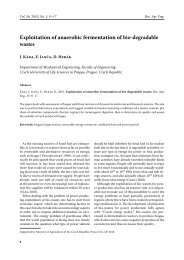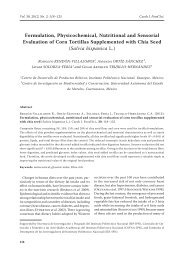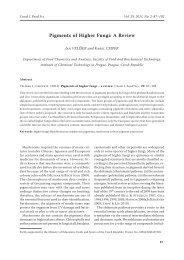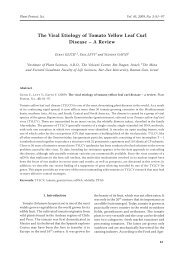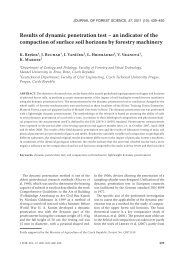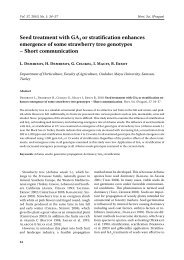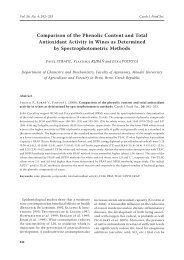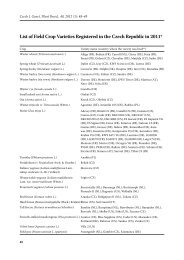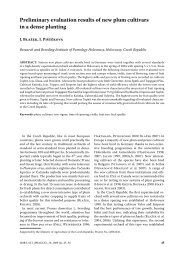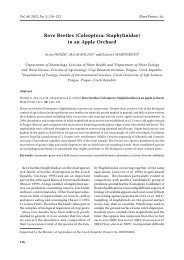Trans Fatty Acid Contents in Chocolates and Chocolate Wafers in ...
Trans Fatty Acid Contents in Chocolates and Chocolate Wafers in ...
Trans Fatty Acid Contents in Chocolates and Chocolate Wafers in ...
Create successful ePaper yourself
Turn your PDF publications into a flip-book with our unique Google optimized e-Paper software.
Vol. 28, 2010, No. 3: 177–184 Czech J. Food Sci.<br />
<strong>and</strong> bitter chocolates groups, respectively. The<br />
percentage of l<strong>in</strong>oleic acid found was 6.074% <strong>and</strong><br />
8.989% <strong>in</strong> chocolate <strong>and</strong> chocolate wafers groups,<br />
respectively (Tables 1 <strong>and</strong> 2).<br />
SFAs contents were found to be higher than<br />
those of MUFAs <strong>and</strong> PUFAs <strong>in</strong> all samples <strong>and</strong><br />
were determ<strong>in</strong>ed to be 61.10%, 60.23%, 56.74%,<br />
56.52%, 53.70%, 51.18%, 49.93%, <strong>and</strong> 47.77%, <strong>in</strong><br />
bitter chocolates, milk chocolates, pure chocolate<br />
wafers, other chocolates, chocolates with almond,<br />
chocolates with pistachio, chocolate wafers with<br />
nuts, <strong>and</strong> chocolates with nuts, respectively. The<br />
percentage of SFA was found to be 55.08%, <strong>and</strong><br />
53.327% <strong>in</strong> chocolate <strong>and</strong> chocolate wafers groups,<br />
respectively (Tables 1 <strong>and</strong> 2).<br />
In our study, the percentages of C 16:1 t9, C 18:1 t9,<br />
C 18:2 t9t12, <strong>and</strong> C 18:2 t9c12 ranged from 0.00% to<br />
0.07%, 0.00% to 0.72%, 0.00% to 0.19%, <strong>and</strong> 0.00% to<br />
0.05%, <strong>in</strong> chocolates groups, respectively (Table 1).<br />
The percentages of C 16:1 t9, C 18:1 t9, C 18:2 t9t12,<br />
<strong>and</strong> C 18:2 t9c12 ranged from 0.03% to 0.03%, 0.56%<br />
to 1.19%, 0.03% to 0.13%, <strong>and</strong> 0.03% to 0.04%, <strong>in</strong><br />
chocolate wafers groups, respectively (Table 2).<br />
Total trans fatty acids contents were found to be<br />
higher <strong>in</strong> chocolate wafers with nuts than <strong>in</strong> other<br />
samples (1.39%). C 18:1 t9 elaidic acid, was found to<br />
be the most abundant trans fatty acid <strong>in</strong> all samples.<br />
TFAs were found <strong>in</strong> all samples of milk chocolates,<br />
pure chocolate wafers, other chocolates, chocolates<br />
with pistachio, chocolates with almond, chocolate<br />
wafers with nuts <strong>and</strong> chocolates with nuts but none<br />
of the TFAs was determ<strong>in</strong>ed <strong>in</strong> bitter chocolates.<br />
M<strong>in</strong>imum <strong>and</strong> maximum ranges of TFAs were determ<strong>in</strong>ed<br />
as 0.00–6.23% <strong>in</strong> the chocolate samples<br />
<strong>and</strong> 0.00–7.92% <strong>in</strong> the wafer chocolate samples<br />
(Table 3). The percentages of TFAs were determ<strong>in</strong>ed<br />
as 0.407% <strong>and</strong> 1.019% <strong>in</strong> chocolates <strong>and</strong> chocolate<br />
wafers groups, respectively (Tables 1 <strong>and</strong> 2).<br />
182<br />
disCussion<br />
Tarkowski <strong>and</strong> Kowalczyk (2007) <strong>in</strong>vestigated<br />
the fatty acids contents <strong>in</strong> milk chocolates marketed<br />
<strong>in</strong> Pol<strong>and</strong>. They analysed fourteen chocolate<br />
samples. It was observed that palmitic, stearic,<br />
oleic, <strong>and</strong> l<strong>in</strong>oleic acids were the predom<strong>in</strong>ant fatty<br />
acids. Similarly, <strong>in</strong> our study, oleic, stearic, palmitic,<br />
<strong>and</strong> l<strong>in</strong>oleic acids were the major fatty acids with<br />
proportions of 36.246%, 28.22%, 23.925%, <strong>and</strong><br />
6.074%, <strong>in</strong> chocolate groups, <strong>and</strong> 34.932%, 19.479%,<br />
25.705%, <strong>and</strong> 8.989% <strong>in</strong> chocolate wafers groups,<br />
respectively. Tarkowski <strong>and</strong> Kowalczyk (2007)<br />
also observed that the chocolates supplemented<br />
with nuts had higher oleic <strong>and</strong> l<strong>in</strong>oleic acids contents.<br />
Similarly, <strong>in</strong> our study, oleic acid was also<br />
found to be conta<strong>in</strong>ed <strong>in</strong> the highest proportion<br />
<strong>in</strong> chocolates with nuts (43.33%).<br />
Demmelmair et al. (1996) <strong>in</strong>vestigated TFAs<br />
contents <strong>in</strong> 42 different br<strong>and</strong>s of spreads <strong>and</strong> cold<br />
meats <strong>in</strong>clud<strong>in</strong>g chocolate spreads consumed by<br />
German children (4–7 years old). They determ<strong>in</strong>ed<br />
trans fatty acid content <strong>in</strong> chocolate spreads <strong>in</strong> the<br />
range of 0.7–11.1%. In our study, TFAs content was<br />
relatively lower than <strong>in</strong> their f<strong>in</strong>d<strong>in</strong>gs. We observed<br />
that TFAs content was 0.0–6.23% <strong>in</strong> chocolates<br />
<strong>and</strong> 0.00–7.92% <strong>in</strong> chocolate wafers.<br />
Wagner et al. (2000) <strong>in</strong>vestigated the contents<br />
of TFAs <strong>in</strong> margar<strong>in</strong>es, plant oils, fried products,<br />
<strong>and</strong> chocolate spreads <strong>in</strong> Austria. They observed<br />
that the levels of TFAs were 0.6–8.9% (mean 4.9%)<br />
<strong>in</strong> chocolate spreads. They suggested the use of<br />
partially hydrogenated fats <strong>in</strong> the manufacture of<br />
these spreads. In our study, we determ<strong>in</strong>ed that<br />
TFAs contents were 0.00–6.23% (mean 0.407%)<br />
<strong>in</strong> chocolates <strong>and</strong> 0.00–7.92% (mean 1.019%) <strong>in</strong><br />
chocolate wafers. Thus, TFAs content <strong>in</strong> chocolates<br />
was <strong>in</strong> Turkey relatively lower than <strong>in</strong> Austria.<br />
Wagner et al. (2000) observed that SFA values for<br />
these spreads ranged between 11.9% <strong>and</strong> 29.4%,<br />
with a mean value of 22.4%. Their observed MUFA<br />
values ranged between 29.0% <strong>and</strong> 43.2% with the<br />
mean value 36.5%, <strong>and</strong> PUFA values ranged between<br />
31.30% <strong>and</strong> 41.90% with the mean value<br />
36.2%. In our study, SFA content was observed as<br />
38.46%–62.81% <strong>in</strong> chocolates <strong>and</strong> 34.75–87.18% <strong>in</strong><br />
chocolate wafers. MUFA content was determ<strong>in</strong>ed<br />
as 28.06%–53.87% <strong>in</strong> chocolates <strong>and</strong> 7.62–53.01%<br />
<strong>in</strong> chocolate wafers. PUFA content was observed,<br />
to be 4.09%–15.24% <strong>in</strong> chocolates <strong>and</strong> 4.32–20.52%<br />
<strong>in</strong> chocolate wafers (Table 3). Indicat<strong>in</strong>g that, SFA<br />
levels were higher <strong>in</strong> Turkey than <strong>in</strong> Austria but<br />
PUFA levels were lower than <strong>in</strong> Austria.<br />
Karabulut (2007) <strong>in</strong>vestigated fatty acids compositions<br />
<strong>and</strong> TFAs contents <strong>in</strong> 134 frequently<br />
consumed foods <strong>in</strong>clud<strong>in</strong>g 19 samples of chocolates<br />
<strong>in</strong> Turkey. The author categorised 7 groups of<br />
chocolates. He stated that chocolate samples conta<strong>in</strong>ed<br />
TFAs less than 0.17 g/100 g fatty acids, with<br />
the exceptional national product of chocolate bars<br />
<strong>and</strong> hazelnut cocoa cream (2.03 <strong>and</strong> 3.68 g/100 g<br />
fatty acids, respectively). He observed that the<br />
dark <strong>and</strong> bitter chocolate samples were found<br />
as trans free products <strong>in</strong> their categories. In our




